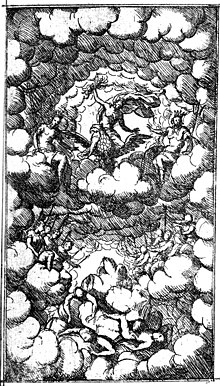La divisione del mondo
| La divisione del mondo | |
|---|---|
| Opera by Giovanni Legrenzi | |
 Illustration from the 1675 libretto | |
| Librettist | Giulio Cesare Corradi |
| Premiere | 4 February 1675 Teatro San Salvador, Venice |
La divisione del mondo (The Division of the World) is an opera in 3 acts by composer Giovanni Legrenzi.[1] The opera uses an Italian-language libretto by Giulio Cesare Corradi and was commissioned by the Marquis Guido Rangoni.[2] The opera tells the story of the division of the world after the Titan deities were defeated by the Olympian gods. The goddess Venus provides the central conflict of the opera through a series of moral temptations which lead all of the other gods, with the exception of Saturn, into debauchery.[1]
La divisione del mondo premiered on 4 February 1675 in Venice at the Teatro San Salvador.[3] The opera was immensely successful at its premiere and became Lengrenzi's most widely performed work, with 13 productions in Italy between 1683 and 1699.[4] Part of the work's success was due to the elaborate and expensive sets, machinery, and special effects employed at its premiere.[2]
In 2000 La divisione del mondo had its first modern revival at the Schwetzingen Festival using a performance score prepared by musicologist Thomas Hengelbrock.[5] The production was directed by Philippe Arlaud and starred Sonora Vaice as Venus, Kobie van Rensburg as Jupiter, Gabriele Sima as Juno, Simone Kermes as Cinzia, Matthias Rexroth in Apollo, Ilana Davidson as Cupid, Bernhard Landauer as Mercury, Hilary Summers as Mars, James Taylor as Neptune, Wolf Matthias Friedrich as Pluto, and Petteri Salomaa as Saturn. Hengelbrock conducted the Balthasar-Neumann-Ensemble.[6]
The opera was revived in March 2019 at the Opéra national de Lorraine in Nancy to widespread acclaim.[7]
Roles[edit]
| Role | Voice type | Premiere cast 4 February 1675 |
|---|---|---|
| Giove (Jupiter), brother of Nettuno and Plutone | tenor | |
| Nettuno (Neptune), brother of Giove and Plutone | tenor | |
| Plutone (Pluto), brother of Giove and Nettuno | baritone | |
| Saturno (Saturn), father of Giove, Nettuno and Plutone | baritone | |
| Giunone (Juno), wife of Giove | mezzo-soprano | |
| Venere (Venus), mother of Amore | soprano | |
| Apollo, brother of Cinzia | contralto | Caterina Forti[8] |
| Marte (Mars), son of Giove and Giunone | contralto | |
| Cinzia (Cynthia), sister of Apollo | soprano | |
| Amore (Cupid), son of Venere | soprano | |
| Mercurio (Mercury), son of Giove | contralto | |
| Discordia (Eris) | contralto |
References[edit]
- ^ a b Bruno Forment (2012). (Dis)embodying Myths in Ancien Régime Opera: Multidisciplinary Perspectives. Leuven University Press. pp. 28–29. ISBN 978-90-5867-900-0.
- ^ a b Alois Maria Nagler (1959). A Source Book in Theatrical History. Courier Corporation. p. 269. ISBN 978-0-486-20515-1.
- ^ Giovanni Legrenzi; Giulio Cesare Corradi. Dario Zanotti (ed.). La divisione del mondo (PDF) (in Italian) – via librettidopera.it.
- ^ Stephen Bonta (2001). "Legrenzi, Giovanni". Grove Music Online (8th ed.). Oxford University Press. doi:10.1093/gmo/9781561592630.article.16314. ISBN 978-1-56159-263-0.
- ^ Horst Koegler (August 2007). "Germany: Schwetzingen". Opera. p. 39.
- ^ "Review: La divisione del mondo". Early Music Review (66): 10–11. 2000.
- ^ Thomé, Michel (22 March 2019). "La Divisione del Mondo à Nancy : crise familiale chez les Jupiter « La Scène «". ResMusica (in French). Retrieved 27 March 2019.
- ^ Beth L(ise) Glixon (2005). Inventing the Business of Opera: The Impresario and His World in Seventeenth-Century Venice. Oxford University Press. p. 176. ISBN 978-0-19-534836-1.
